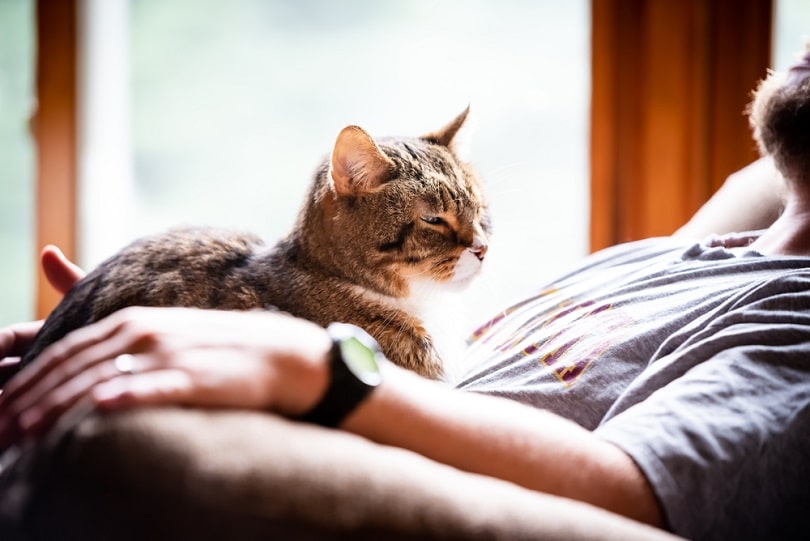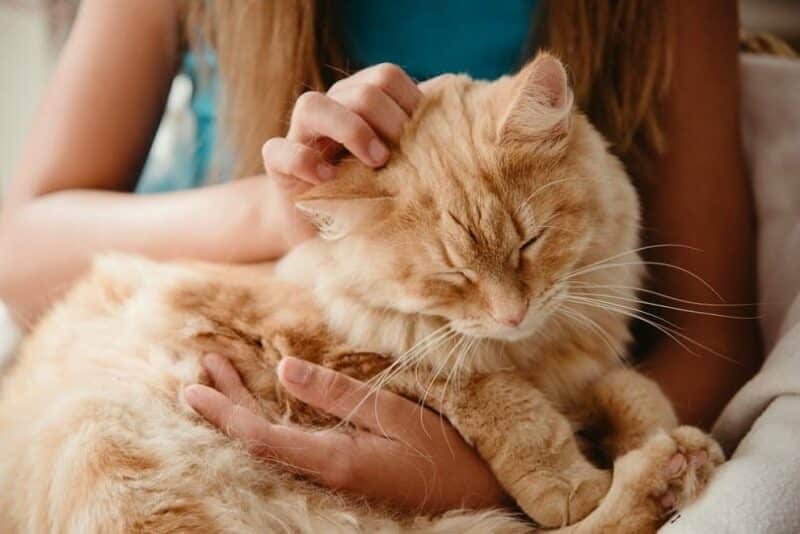Cats have quite a few strange behaviors. Even if you’ve been living with cats forever, you may still be surprised by their behavior every once in a while. For instance, some cats may clean themselves while lying in their owner’s lap.
Typically, when cats lie in our lap, we believe that they are cuddling with us. However, this sort of behavior proves a different point. In some cases, the cat may not even be paying attention to you!
As cat owners, we know how strangely cats can act—and how hard it can be to determine the intent behind your cat’s actions. Therefore, we put together this list of potential reasons that your cat may clean themselves while sitting in your lap and how to know whether you should be worried about this behavior.
The 4 Possible Reasons Your Cat Cleans Herself on You
1. You’re Comfortable
One of the most apparent reasons your feline may clean themselves on you is that you’re pretty comfortable. Cats will often groom themselves wherever they are the most comfortable. For many felines, that may be right on your lap!
It isn’t that they’re ignoring you. Grooming is simply a task that most cats enjoy, so many of them do it as much as possible. If that means fitting in a grooming schedule while they are also cuddling with you, so be it.
Furthermore, many cats may cuddle with you without the intent of grooming at first. Then, they may decide to groom after they relax with some cuddles.

2. It Releases Dopamine
Grooming releases dopamine. In other words, it makes your cat feel quite good. For this reason, many of them may decide to groom themselves in the middle of a cuddle session, which likely releases some serotonin.
Because serotonin is released when cats groom, many associate grooming with serotonin release. Usually, serotonin is also released when they are petted and cuddled (which is why they like that so much). Therefore, it only makes sense that they may start grooming whenever they begin to feel relaxed during a cuddle session.
This isn’t necessarily a bad thing. It can mean that your cat likes bonding with you, and they want to increase the good vibes!
3. They’re Bonding
Many cats will participate in allogrooming in the wild, which means that they groom each other. Of course, a cat does not get much practical benefit out of grooming another cat. It doesn’t keep them clean, after all. However, it does help mix two cats’ scents together, signifying that they are in the same family group.
Cats primarily identify each other by scent. If you remove one cat from the household and reintroduce them after months or years, the other cats won’t recognize them because they will smell so different. For instance, littermates will often not identify each other years later.
As you can see, it is pretty essential and ingrained in a cat’s behavior. However, your cat cannot exactly groom you—you don’t have any fur. While some cats will still attempt to groom their humans, others understand it isn’t quite the same. Still, it isn’t odd for many cats to feel the urge to groom, anyway. In this case, your feline may decide to groom themselves since you are pretty ungroomable!

4. They’re in Pain
Because grooming releases dopamine, it is also a natural pain reliever. Therefore, cats may groom even more when in pain or sick. Cats are extremely good at hiding their signs. They would need to hide their illnesses in the wild, or a predator may have taken advantage of their weakness. Covering up that they were in pain was vital to their survival. That isn’t much of a problem in today’s world.
However, cats still instinctively do it. Therefore, even if you don’t notice any other signs, your cat could still be overgrooming to handle pain. They may still want to cuddle but be in pain for one reason or another. In this way, they may decide to groom themselves while cuddling.
When Should You Worry?
Typically, you do not need to worry about your cat grooming themselves while cuddling. It is a relatively normal behavior that is likely occurring because your cat is relaxed and happy. There is no reason to interrupt it. However, there are some cases where you may need to consider taking your cat to the vet.
One of these situations is overgrooming. If your feline is grooming themselves too much, it can signify various problems. Often, cats will overgroom if they have arthritis, for instance. Any source of pain can also be a source of overgrooming.
If your cat is genuinely overgrooming, they will start to pull out fur and even leave sores. If your cat is experiencing this problem, you should take them to the vet, as it can be a sign of underlying problems.
Occasionally, you should also pay extra attention when your cat begins grooming on you suddenly. While this isn’t always a problem (cats do change some of their habits without an underlying issue), it can also indicate a health problem. It may be the start of overgrooming, even if they are not yet losing fur or developing sores.

How Can You Prevent This Behavior?
In many cases, you don’t need to prevent this behavior. It is normal and likely caused by your cat liking the cuddle session. However, if you do want to prevent your cat from grooming themselves on you, there are several steps you can take.
For example, you can try a distraction. This will often stop the cuddle session, so use this method wisely. You can throw a ball or shift to playing with your cat, typically making them stop cuddling and start playing.
With that said, these distractions don’t always work. In some cases, it is best to end the cuddle session as soon as they start grooming. Remove your cat from your lap and move elsewhere. After a few times, your cat will figure out why you stood up, though it is essential to be consistent.
Conclusion
Your cat may groom in your lap for several reasons. First, they may decide that your lap is simply the most comfortable place to groom. It is where they feel safe. Second, they may groom naturally when they start to relax in your lap or attempt to bond with you.
However, because felines also groom for pain relief, grooming isn’t always as simple as it’s made out to be. Sometimes, cats may have underlying health problems that cause pain, so they’re attempting to “self-medicate” by grooming.
If your cat suddenly starts grooming in your lap and in other situations where they once didn’t, you may want to look at their behavior. Even if they don’t have fur loss or sores yet, they may develop them. When in doubt, always speak to your vet.
Related Reads:
Featured Image Credit: Karpova, Shutterstock













